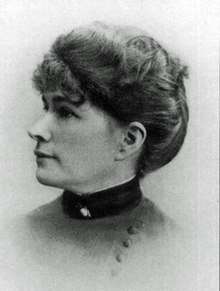Katharine Dooris Sharp
E. Katharine Dooris Sharp (1846–1935) was an American botanist, poet, and suffragist. She was the author of Summer in a Bog.[1]
Katharine Dooris Sharp | |
|---|---|
 | |
| Born | Emily Katharine Dooris 1846 |
| Died | 1935 (aged 88–89) |
| Nationality | Irish-American |
| Occupation | Writer, Botanist, Suffragist |
| Spouse(s) | Henry James Sharp |
Biography
Emily Katharine Dooris was born in Ulster, Ireland and raised in Zanesville, Ohio.[2] She married Henry James Sharp, a medical doctor, around 1872.[3] The couple lived in London, Ohio, where Sharp became interested in botany. She contributed more than 400 specimens to the State Herbarium of Ohio during the period of 1899-1906. One of these, Armoracia aquatica, was rare to the area.[3]
Sharp began her writing career with a volume of poems, Eleanor's Courtship and The Songs that Sang Themselves, published in 1888. She also wrote fiction and non-fiction.[2] Sharp supported women's suffrage and wrote a series of articles, entitled "Women and the Elective Franchise," in a local newspaper around 1894.[2]
Partial Bibliography
- Eleanor's Courtship and The Songs that Sang Themselves. Cincinnati: Robert Clarke & Co, 1888.[4]
- The South Ward. Cincinnati: Cranston & Stowe; New York: Hunt & Eaton, 1891.[5]
- The Doctor's Speaking Tube and other poems. Boston: Badger, 1904.
- Summer in a Bog. Cincinnati: Stewart & Kidd, 1913.
- "Our National Flower," Science, 47 (1225), June 21, 1918. p. 611-12. doi:10.1126/science.47.1225.611
References
- Stuckey, Ronald L. (1992). Women Botanists of Ohio: Born Before 1900 : with Reference Calendars from 1776 to 2028. RLS Creations. pp. 13–14. Retrieved August 4, 2018.
- "Katharine Dooris Sharp". The Magazine of Poetry. 6 (10): 440–442. 1894. Retrieved August 4, 2018.
- Bonta, Marcia (1995). "Katharine Dooris Sharp". American Women Afield: Writings by Pioneering Women Naturalists. Texas A&M University Press. pp. 55–61. ISBN 9780890966341. Retrieved August 4, 2018.
- Sharp, Katharine (Dooris) (1888). Eleanor's courtship and The songs that sang themselves. Cincinnati. hdl:2027/loc.ark:/13960/t6931h80f.
- Sharp, Katharine Dooris (1891). The south ward. Cinninnati & New York. hdl:2027/osu.32435054741897.